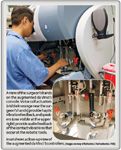Article
Vibrotactile feedback enhances robotic urologic surgery, according to study
Adding vibrotactile feedback to robotic minimally invasive surgery can increase awareness of tool actions and surgeons' perceived ability to concentrate.
Washington-Adding vibrotactile feedback to robotic minimally invasive surgery can increase awareness of tool actions and surgeons' perceived ability to concentrate, according to a user study presented at the AUA annual meeting in Washington.

"The vibrations provided by this system are similar to what surgeons can hear and feel if they were directly manipulating the instruments," said first author William McMahan, a PhD candidate at the University of Pennsylvania, Philadelphia, working with Katherine J. Kuchenbecker, PhD, David I. Lee, MD, and colleagues.
McMahan described the features and components of the VerroTouch. A central receiver conditions the vibration signals to drive the audio and haptic outputs. An independent gain control allows for customization of the strength of the audio and haptic feedback to the surgeon's preference.
Voice coil actuators mounted near the surgeon's hands generate haptic feedback of the tool vibrations. Stereo computer speakers mounted to the sides of the master console provide the audio feedback.
"We give them the audio because the audio and haptics often reinforce each other," McMahan said.
In a user study of an engineering prototype of the VerroTouch, 11 surgeons of varying specialty-three with significant clinical experience with robotic surgery-were asked to execute a series of three in vitro manipulation tasks (peg transfer, needle pass, suturing) with the da Vinci S Surgical System augmented with VerroTouch. Each task was performed under four different feedback conditions: visual only, visual with audio feedback of tool vibrations, visual with haptic feedback of tool vibrations, and visual with both audio and haptic feedback. None of the surgeons had prior experience with the VerroTouch.
For each task, completion time, tool accelerations, and forces applied by the surgical instruments to the task materials were recorded. Each surgeon also provided preference ratings of each feedback condition.
Surgeons favor feedback
"Every surgeon expressed a preference for one of the tool vibration feedback methods," McMahan said.
"Some liked the haptics more than the audio or the audio more than the haptics. Every time, they preferred having some sort of feedback over the normal da Vinci."
The mean preference rating for each surgeon's favorite condition was 0.80; for the unaugmented da Vinci, it was 0.58 (maximum score=1.0; higher rating indicates higher preference).
Surgeon comments indicated that the tool vibration feedback provides greater awareness of the task environment and the robot state that may not be available visually. The additional awareness/feedback may allow for more controlled movement of the robot without compromising the speed, accuracy, or force with which the surgeons completed the assigned tasks.
The total hardware cost of the vibrotactile feedback additions to the da Vinci system was about $1,000 to $2,000, McMahan said.
For the next phase of study, "We're going to do some more extensive user studies to try to prove that it's more useful with some quantitative metrics," he said.
Dr. Lee is a consultant/adviser for Pfizer Inc., Intuitive Surgical, Inc., and Ethicon Endo-Surgery.





